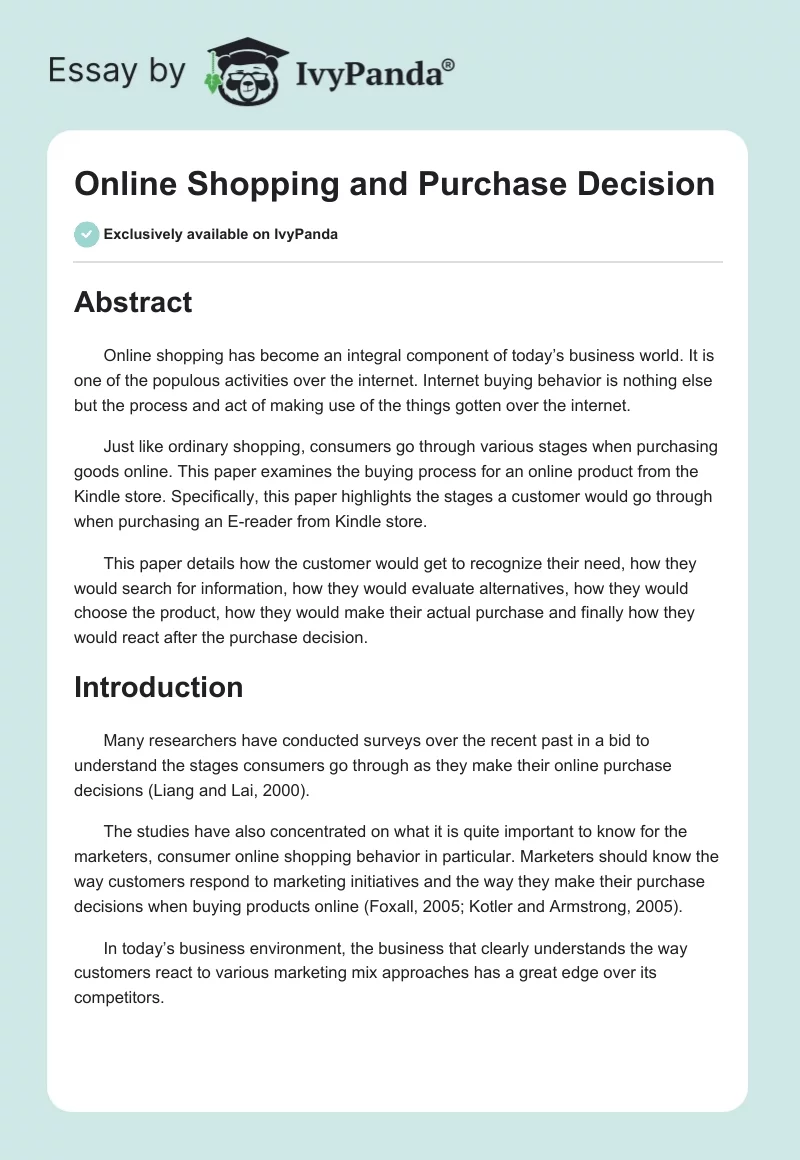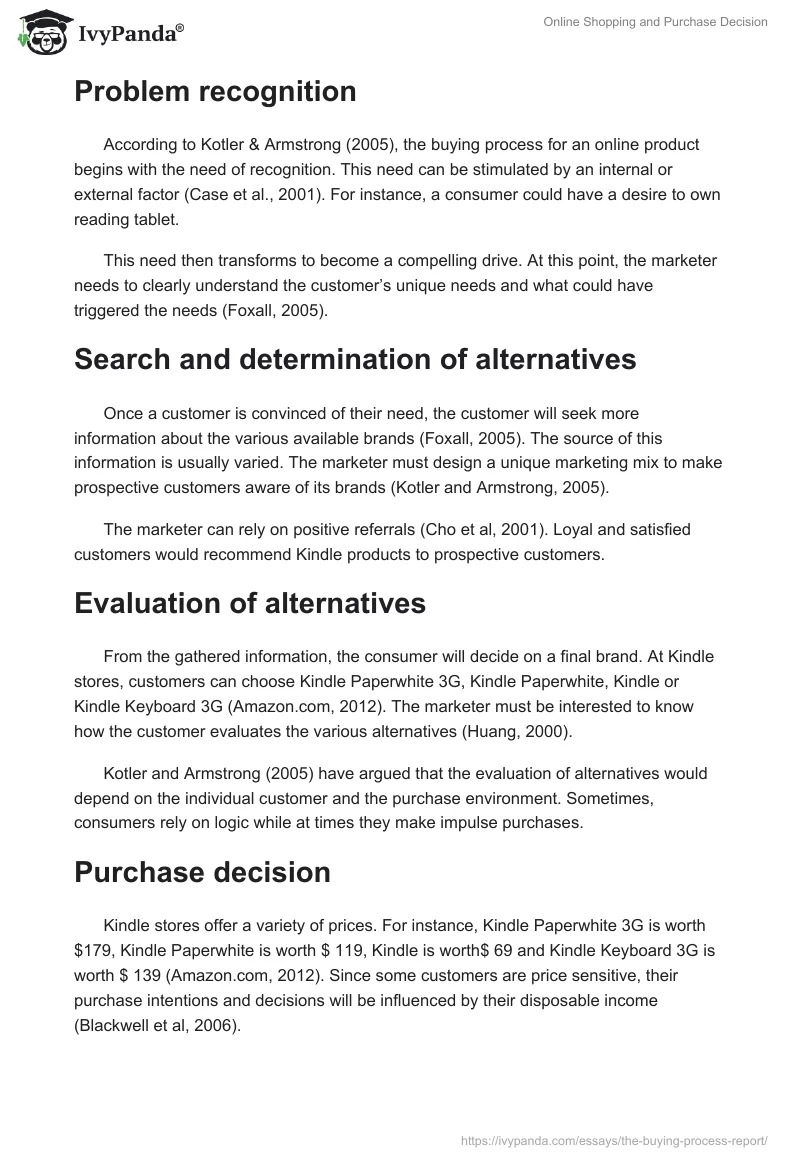Abstract
Online shopping has become an integral component of today’s business world. It is one of the populous activities over the internet. Internet buying behavior is nothing else but the process and act of making use of the things gotten over the internet.
Just like ordinary shopping, consumers go through various stages when purchasing goods online. This paper examines the buying process for an online product from the Kindle store. Specifically, this paper highlights the stages a customer would go through when purchasing an E-reader from Kindle store.
This paper details how the customer would get to recognize their need, how they would search for information, how they would evaluate alternatives, how they would choose the product, how they would make their actual purchase and finally how they would react after the purchase decision.
Introduction
Many researchers have conducted surveys over the recent past in a bid to understand the stages consumers go through as they make their online purchase decisions (Liang and Lai, 2000).
The studies have also concentrated on what it is quite important to know for the marketers, consumer online shopping behavior in particular. Marketers should know the way customers respond to marketing initiatives and the way they make their purchase decisions when buying products online (Foxall, 2005; Kotler and Armstrong, 2005).
In today’s business environment, the business that clearly understands the way customers react to various marketing mix approaches has a great edge over its competitors.
Problem recognition
According to Kotler & Armstrong (2005), the buying process for an online product begins with the need of recognition. This need can be stimulated by an internal or external factor (Case et al., 2001). For instance, a consumer could have a desire to own reading tablet.
This need then transforms to become a compelling drive. At this point, the marketer needs to clearly understand the customer’s unique needs and what could have triggered the needs (Foxall, 2005).
Search and determination of alternatives
Once a customer is convinced of their need, the customer will seek more information about the various available brands (Foxall, 2005). The source of this information is usually varied. The marketer must design a unique marketing mix to make prospective customers aware of its brands (Kotler and Armstrong, 2005).
The marketer can rely on positive referrals (Cho et al, 2001). Loyal and satisfied customers would recommend Kindle products to prospective customers.
Evaluation of alternatives
From the gathered information, the consumer will decide on a final brand. At Kindle stores, customers can choose Kindle Paperwhite 3G, Kindle Paperwhite, Kindle or Kindle Keyboard 3G (Amazon.com, 2012). The marketer must be interested to know how the customer evaluates the various alternatives (Huang, 2000).
Kotler and Armstrong (2005) have argued that the evaluation of alternatives would depend on the individual customer and the purchase environment. Sometimes, consumers rely on logic while at times they make impulse purchases.
Purchase decision
Kindle stores offer a variety of prices. For instance, Kindle Paperwhite 3G is worth $179, Kindle Paperwhite is worth $ 119, Kindle is worth$ 69 and Kindle Keyboard 3G is worth $ 139 (Amazon.com, 2012). Since some customers are price sensitive, their purchase intentions and decisions will be influenced by their disposable income (Blackwell et al, 2006).
Alternatively, the customer can decide to buy based on the potential benefits of the product (Case et al, 2001). Since customers will only buy when they believe that price of the E-reader is tantamount to its benefits (Kotler and Armstrong, 2005), the marketer should price the product appropriately so that customers can get their perceived value.
Post-purchase evaluation
After buying the product, the customer will either be contented or not. The customer will display some post purchase reaction which the marketer must be interested in (Kotler and Armstrong, 2005). This reaction will be influenced by the relationship between the customer’s expectation and the actual performance of the product.
If the customers’ expectations are not met by the product, the customer will be very dissatisfied (Foxall, 2005). Therefore, the marketer must only claim what is in tandem with the products’ actual performance to achieve customer satisfaction.
Conclusion
The above is a detailed explanation of the buying process for an online product specifically E-reader from Kindle. Consumers follow these stages as they seek to make a purchase decision (Kotler and Armstrong, 2005). However, the customer might not necessarily follow the above stages sequentially.
When buying an online product, the consumer will first recognize their problem. The customer will then proceed to search and determine the various alternatives available.
The customer will then evaluate the alternatives and make a purchase decision (Kotler and Armstrong, 2005). Finally, the customer will engage in post-purchase evaluation.
References
Amazon.com. (2012). The world’s best-selling E-readers. Web.
Blackwell, D. R., Miniard, P. W., & Engel, J. F. (2006). Consumer behaviour 10th Edition. USA: Thomson Learning.
Case, T., Burns, O. M., & Dick, G. N. (2001). Drivers of on-line purchasing among U.S. university students. Proceedings of the 7th Americas Conference on Information Systems, 873-878.
Cho, Y., Im, I., Hiltz, R., & Fjermestad, J. (2001). Causes and outcomes of online customer complaining behavior: Implications for customer relationship management (CRM). Proceedings of the 7th Americas Conference on Information Systems, 900-907.
Foxall, G. (2005.) Understanding consumer choice. Basingstoke: Palgrave Macmillan.
Huang, M. (2000). Information load: Its relationship to online exploratory and shopping behavior. International Journal of Information Management 20: 337–347.
Kotler, P., & Armstrong, G. (2005). Principles of marketing 11th Edition. USA: Prentice Hall.
Liang, T., & Lai, H. (2000). Electronic store design and consumer choice: An empirical study. Proceedings of the 33rd Hawaii International Conference on System Sciences. Web.


